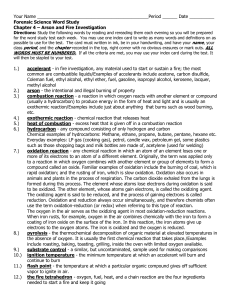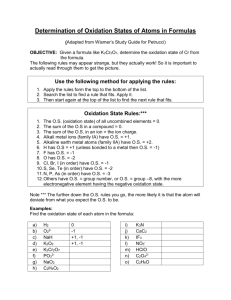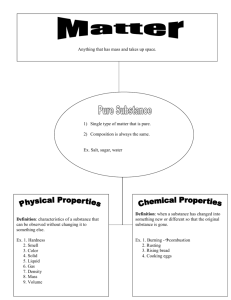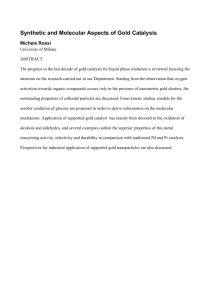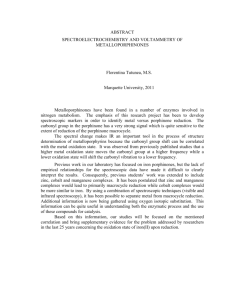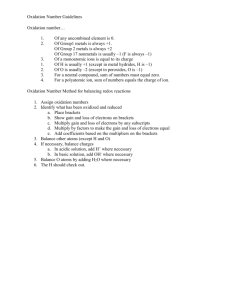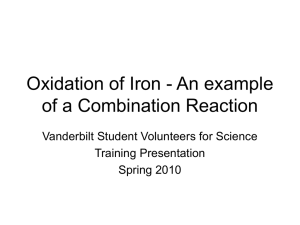Teacher Materials - Scope, Sequence, and Coordination
advertisement
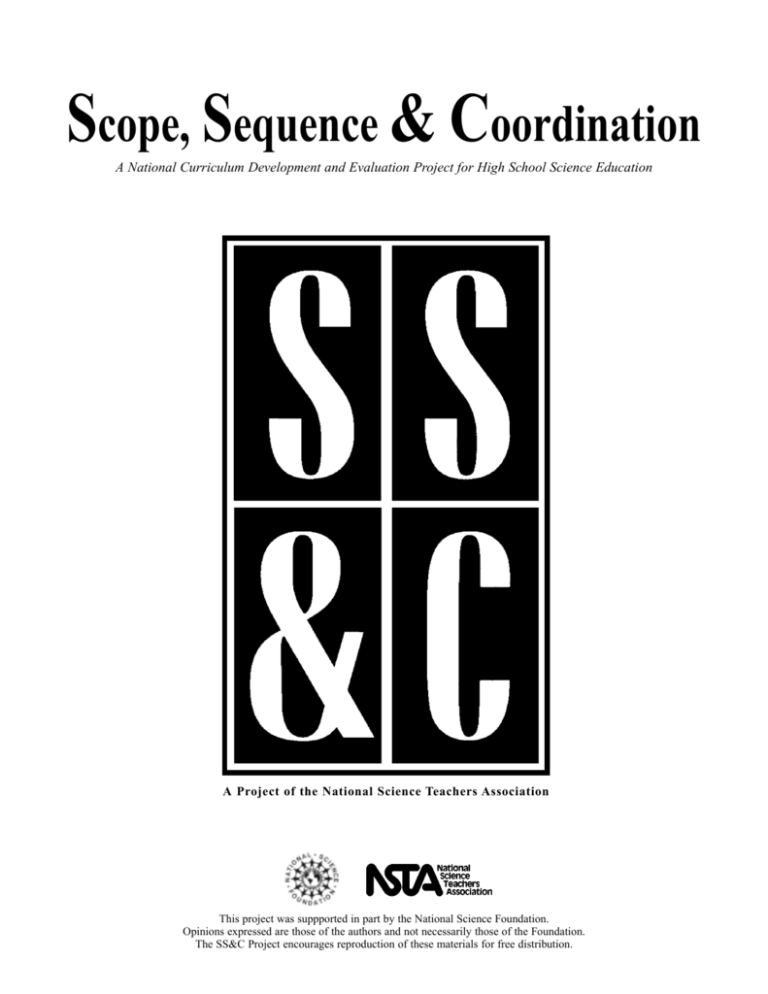
Scope, Sequence & Coordination A National Curriculum Development and Evaluation Project for High School Science Education A Project of the National Science Teachers Association This project was suppported in part by the National Science Foundation. Opinions expressed are those of the authors and not necessarily those of the Foundation. The SS&C Project encourages reproduction of these materials for free distribution. Scope, Sequence & Coordination SS&C Research and Development Center Iowa Coordination Center Bill G. Aldridge, Principal Investigator and Project Director* Dorothy L. Gabel, Co-Principal Investigator Erma M. Anderson, Associate Project Director Nancy Erwin, SS&C Project Editor Rick McGolerick, Project Coordinator Robert Yager, Center Director Keith Lippincott, School Coordinator University of Iowa, 319.335.1189 Evaluation Center Frances Lawrenz, Center Director Doug Huffman, Associate Director Wayne Welch, Consultant University of Minnesota, 612.625.2046 Houston SS&C Materials Development and Coordination Center Linda W. Crow, Center Director Godrej H. Sethna, School Coordinator Martha S. Young, Senior Production Editor Yerga Keflemariam, Administrative Assistant Baylor College of Medicine, 713.798.6880 Houston School Sites and Lead Teachers Jefferson Davis H.S., Lois Range Lee H.S., Thomas Goldsbury Jack Yates H.S., Diane Schranck Iowa School Sites and Lead Teachers Pleasant Valley H.S., William Roberts North Scott H.S., Mike Brown North Carolina Coordination Center Charles Coble, Center Co-Director Jesse Jones, Center Co-Director East Carolina University, 919.328.6172 North Carolina School Sites and Lead Teachers Tarboro H.S., Ernestine Smith Northside H.S., Glenda Burrus Puerto Rico Coordination Center** Manuel Gomez, Center Co-Director Acenet Bernacet, Center Co-Director University of Puerto Rico, 809.765.5170 Puerto Rico School Site UPR Lab H.S. California Coordination Center Tom Hinojosa, Center Coordinator Santa Clara, Calif., 408.244.3080 California School Sites and Lead Teachers Lowell H.S., Marian Gonzales Sherman Indian H.S., Mary Yarger Sacramento H.S., Brian Jacobs Pilot Sites Site Coordinator and Lead Teacher Fox Lane H.S., New York, Arthur Eisenkraft Georgetown Day School, Washington, D.C., William George Flathead H.S., Montana, Gary Freebury Clinton H.S., New York, John Laffan** Advisory Board Dr. Rodney L. Doran (Chairperson), University of Buffalo Dr. Albert V. Baez, Vivamos Mejor/USA Dr. Shirley M. Malcom, American Association for the Advancement of Science Dr. Shirley M. McBay, Quality Education for Minorities Dr. Mary Budd Rowe, Stanford University Dr. Paul Saltman, University of California, San Diego Dr. Kendall N. Starkweather, International * Western NSTA Office, 394 Discovery Court, Henderson, Nevada 89014, 702.436.6685 ** Not part of the NSF-funded SS&C project. Technology Education Association Dr. Kathryn Sullivan, NOAA National Science Education Standard—Physical Science Chemical Reactions A large number of important reactions involve the transfer of either electrons (oxidation/reduction reactions) or hydrogen ions (acid/base reactions) between reacting ions, molecules, or atoms. In other reactions, chemical bonds are broken by heat or light to form very reactive radicals with electrons ready to form new bonds. Radical reactions control many processes such as the ozone and greenhouse gases in the atmosphere, burning and processing of fossil fuels, formation of polymers, and explosions. Teacher Materials Learning Sequence Item: 958 Oxidation March 1996 Adapted by: Marian Gonzalez, Brett Pyle and Linda W. Crow Oxidation/Reduction, Acid/Base, and Radical Reactions. Students should define oxidation as a process in which oxygen combines with another element. They should distinguish between fast oxidation as in combustion and slow oxidation as in rusting. (Chemistry, A Framework for High School Science Education, p. 68.) Contents Matrix Suggested Sequence of Events Lab Activities 1. Watery Burning 2. When an Old Flame Dies 3. Burnin' Steel 4. Rusting Assessment 1. Oxidation 2. Reaction Speed 3. Oxidation 4. Rusting 5. Oxidation 6. Welding 7. Rust Prevention 8. Rust Prevention 9. Combustion This micro-unit was adapted by Marian Gonzalez (Lowell H.S., San Francisco, Calif.), Brett Pyle (Grady Middle School, Houston, Texas), and Linda W. Crow (Baylor College of Medicine, Houston, Texas) 3 958 Oxidation/Reduction, Acid/Base, and Radical Reactions. Students should define oxidation as a process in which oxygen combines with another element. They should distinguish between fast oxidation as in combustion and slow oxidation as in rusting. (Chemistry, A Framework for High School Science Education, p. 68.) Learning Sequence Science as Inquiry Science and Technology Science in Personal and Social Perspectives Watery Burning Lab Activity 1 Camping Stoves Reading 4 Fireside Dreams Reading 3 When an Old Flame Dies Lab Activity 2 Oxidation Assessment 1, 3 Reaction Speed Assessment 2 Burnin' Steel Lab Activity 3 Rusting Assessment 4 Oxidation Assessment 3 Rusting Lab Activity 4 Welding Assessment 6 Rusting Assessment 4 Oxidation Assessments 1, 3 Rust Prevention Assessments 7, 8 Reaction Speed Assessment 2 Combustion Assessment 9 4 History and Nature of Science Tin and Lead Change in Weigtht Reading 1 Lavoisier's Famous Notes Reading 2 Oxidation Assessment 5 Suggested Sequence of Events Event #1 Lab Activity 1. Watery Burning (20 minutes) Alternative or Additional Activities 2. When an Old Flame Dies (30 minutes) 3. Burnin' Steel (30 minutes) Event #2 Lab Activity 4. Rusting (one hour) Event #3 Readings from Science as Inquiry, Science and Technology, Science in Personal and Social Perspectives, and History and Nature of Science Students select 2 or 3 from this list: Reading 1 Reading 2 Reading 3 Reading 4 Tin and Lead Change in Weight Lavoisier's Famous Notes Fireside Dreams Camping Stoves The above readings can be found in the student version of this publication. Assessment items can be found at the back of this volume. 5 Assessment Recommendations This teacher materials packet contains a few items suggested for classroom assessment. Often, three types of items are included. Some have been tested and reviewed, but not all. 1. Multiple choice questions accompanied by short essays, called justification, that allow teachers to find out if students really understand their selections on the multiple choice. 2. Open-ended questions asking for essay reponses. 3. Suggestions for performance tasks, usually including laboratory work, questions to be answered, data to be graphed and processed, and inferences to be made. Some tasks include proposals for student design of such tasks. These may sometimes closely resemble a good laboratory task, since the best types of laboratories are assessing student skills and performance at all times. Special assessment tasks will not be needed if measures such as questions, tabulations, graphs, calculations, etc., are incorporated into regular lab activities. Teachers are encouraged to make changes in these items to suit their own classroom situations and to develop further items of their own, hopefully finding inspiration in the models we have provided. We hope you may consider adding your best items to our pool. We also will be very pleased to hear of proposed revisions to our items when you think they are needed. 6 958 Activity 1 Teacher Sheet Science as Inquiry Watery Burning How can paper undergo spontaneous combustion? Materials: Per lab group: tissue paper 1–2 grams sodium peroxide (Na2O2) small piece of ice slab of metal as insulator Procedure: Have the students tear up the tissue into small pieces and stack it on the insulating slab. They should then place 1–2 grams of sodium peroxide on the tissue. Next they place a small chip of ice on the top of the stack and observe the results. Background: At room temperature the ice will melt and the water will react with the sodium peroxide as shown: Na2O2 + H2O —> 2NaOH + O + energy (heat) The oxygen released from the above reaction is in elemental form and thus very reactive. It immediately reacts with the paper pieces and sets them on fire. In grade 9, students do not balance equations. You may wish to use a word equation and emphasize that the oxygen produced reacts with the paper to produce the fire. Further Variations: There are some other materials that can be substituted in place of the paper. Fine sugar, coal dust, or lycopodium powder may also be used. Adapted by M. Gonzalez (Lowell High School, San Francisco), L. Crow (Baylor College of Medicine, Houston), and B. Pyle (Grady Middle School, Houston) from: Liem, T., Invitations to Science Inquiry, 2nd ed. Chino Hills, Calif.: Science Inquiry Enterprises, 1990. 7 958 Activity 2 an alternative/extension activity for Event 1 Teacher Sheet Science as Inquiry When an Old Flame Dies What affects the combustion of a candle flame? Materials: Per lab group: candle sheet of paper matches 500 mL beaker or can of sand Procedure: Part A: Have students roll the sheet of paper into a tight cylinder about 2–3 cm in diameter. They should light one end of the paper roll and hold it near horizontal with the burning end slightly up. One student should blow a short puff of air into the tube while the other lab partners observe the results. They should should not place their lips on the paper nor inhale through the tube! When they blow, they should see a brighter flash of light and hear a slight plop sound. Have students extinguish the paper rolls in the can of sand. Part B: Have students light the candle and allow it to burn for 10–20 seconds (until the wax begins melting). They should then light another match and blow out the candle while keeping the match lit. Have them hold the burning match in the smoke trail of the candle about 3-4 cm from the wick. Students should observe the flame traveling back to the wick. Background: Part A: When holding the paper roll, students should be careful to always hold the burning end slightly upward to prevent smoke and fumes from traveling up the tube toward the mouth. The experiment actually works best with the tube held horizontal so that some smoke is trapped in the tube when the student blows into it. This mixture of smoke and air reacts with the flame to produce a bright flash and the plopping sound. Part B: What is actually burning in a candle flame is the vaporized wax from the candle. When first lit it is the wick itself that is burning. This melts the surrounding wax, which is drawn up the wick and is vaporized, feeding the flame. When a candle is blown out the wick continues heating some wax, but it does not completely combust, thus producing the smoke trail. The smoke trail is actually vaporized wax particles and so is highly combustible. Holding a flame in the smoke trail will reignite it. This part works best in still air so that the smoke trail is not broken up. 8 958 Activity 2 Trick candles that do not blow out have wax that contains red phosphorous. When the flame is blown out, the glowing wick sparks the phosphorous which reignites the candle. Further Variations: After the students have conducted the experiment with the candles, provide them with some trick candles and have them investigate why these candles behave differently. Adapted by M. Gonzalez (Lowell High School, San Francisco), L. Crow (Baylor College of Medicine, Houston), and B. Pyle (Grady Middle School, Houston) from: Liem, T., Invitations to Science Inquiry, 2nd ed. Chino Hills, Calif.: Science Inquiry Enterprises, 1990. 9 958 Activity 3 an alternative/extension activity for Event 1 Teacher Sheet Science as Inquiry Burnin’ Steel What are the effects of surface area on oxidation? Materials: Per lab group: steel wool chunk of steel bunsen burner matches tongs piece of copper 500 mL beaker or can of sand Procedure: Have the students polish a part of the chunk of steel with the steel wool. Next have them hold a match under the chunk of steel for several seconds. They should observe the outside appearance of the steel, looking for a tarnish that indicates oxidation has occurred. Have them repeat the experiment on the piece of copper and observe the tarnish that forms. After recording their observations, have them hold the steel wool with the tongs and hold a match under it. They should again record their observations. If the steel wool catches on fire, have the students place it in the beaker of sand. Background : An increase in surface area will greatly increase the rate of oxidation of a substance. In this experiment, a chunk of steel will discolor and tarnish when heated, indicating oxidation is occurring. The steel wool, with a much greater surface area, oxidizes much more rapidly to the point of combustion. Further Variations: The students could test various metals such as copper, aluminum, iron, brass, etc., to observe the amount of tarnish produced when they are held over the bunsen burner. This will relate to a later activity (Activity 5), which examines rates of slow oxidation among different metals. Adapted by M. Gonzalez (Lowell High School, San Francisco), L. Crow (Baylor College of Medicine, Houston), and B. Pyle (Grady Middle School, Houston) from: B. Aldridge, personal communication, 1995. 10 958 Activity 4 an alternative/extension activity for Event 2 Teacher Sheet Science as Inquiry Rusting Reactions of oxygen with metals. Materials: 8 clear containers (per person or per group) 4 iron nails 4 galvanized nails 4 brass nails 4 copper nails 1 dropper bottle of salt water or marine water 1 dropper bottle of oil 1 dropper bottle of distilled water (or plain water) 1 scoop of CaCl2 or commercial drying material Procedure: Iron nails are the experimental group and galvanized nails are the control group. Copper, aluminum, or painted nails can be substituted. The following are examples and can be modified. 1. 2. 3. 4. 5. 6. control with water layer of oil on top of water sea water or salt water, air calcium chloride with a cork to keep out air oil and water, zinc nail in tap water The students should observe changes over time in the various containers and record these observations in a log. Each group can set up one container or, if materials allow, have each group set up all of the containers. Discuss with the students the variables that do and do not affect the oxidation rate of the nails. Background: Slow oxidation can be observed by a rusting nail. Oxidation is a problem with many products around the home. This can demonstrated by a single teacher setup with students making daily observations or done at home with end products brought to class and data entered into a journal. This can also be used as an assessment tool. Encourage the students to set up various conditions to see when rusting will occur. They don’t have to be confined to the examples listed. Fe(solid) + 2H+ (acid) —> Fe++(dissolved) + H2 (gas) Each iron atom has lost two electrons to hydrogen. The iron is oxidized and the hydrogen is reduced. Rusting is a slow process of combining oxygen with metals, usually iron. Iron and its compounds are 11 958 Activity 4 found almost everywhere. About 6 percent of the earth is iron. Since the Iron Age, man has tried to protect iron from oxygen, acids, and salts. These substances corrode the iron and many methods have been developed that slow down the process. The corrosion becomes more rapid as the surface area or the concentration of salt is increased. Table 1: Methods of protecting surfaces Method Protection Finished appearance Relative cost zinc plating very good dull silvery medium chromium plating good bright, shiny high painting (after sand blasting) fairly good color of paint medium painting (after ordinary cleaning) fair color of paint medium/low painting on top of rust poor color of paint low Table 2: Some metals listed in order of decreasing reactivity aluminum, Al zinc, Zn chromium, Cr iron, Fe tin, Sn gold, Au Further Variations: Try this experiment using copper pennies minted before 1981 and after 1981. Get a piece of galvanized metal pipe and have it attached to a similar piece of copper pipe. Leave it in water and watch what happens. Why does home plumbing now use copper and/or plastic pipe? This is galvanic corrosion. The iron, anode, is more active than the copper, cathode, so the iron corrodes faster. Recently the Statue of Liberty had to have its internal iron works replaced. What is the outer shell made of? Does it rust? Students might be encouraged to interview people who must deal with rust problems. What does it cost to get extra protection for the car or indoor plumbing? How does it work? How much does a city spend on protecting structures such as bridges. What areas of the U.S. have the most severe rusting conditions? Least severe conditions? Was there a difference between using salt water and plain water? Give students the two tables and ask questions about oxidation rates and oxidation protection. Adapted by M. Gonzalez (Lowell High School, San Francisco), L. Crow (Baylor College of Medicine, Houston), and B. Pyle (Grady Middle School, Houston) from: Holman, John, The Material World, 1971. 12 958 Assessment 1 Science as Inquiry/ Science and Technology Oxidation Item: A nail rusting, and a gas jet burning with a blue flame have the following in common: 1. they are examples of exothermic (heat releasing) chemical change 2. they are examples of reactions with oxygen 3. they form carbon dioxide gas as a product A. B. C. D. 1 only 2 only 1 and 2 only 1, 2, and 3 Justification: Describe as fully as you can what is taking place when a nail rusts, and when a gas jet burns. Answer: C. The connection is that they are both examples of exothermic chemical change via oxidation reaction, or reaction of chemical substances with oxygen in the air. When a nail rusts, iron is reacting with oxygen in the air to form iron oxide. When a gas jet burns, methane in the gas (CH4) is reacting with oxygen to form water and carbon dioxide gas. .. 13 958 Assessment 2 Science as Inquiry/ Science in Personal and Social Perspectives Reaction Speed Item: A packet of chemicals can be purchased at a drug store that gets hot when you mix the chemicals in the bag. The overall chemical reaction that occurs inside the bag is the conversion of fine iron metal powder to iron oxide (rust). When you touch an iron fence that is going rusty, you do not feel that it is usually warm. This is because: A. B. C. D. the chemical reaction of iron rusting on the fence in the air does not release heat the iron on the fence conducts the heat away a hand is not a good detector for heat, sometimes things feel hotter and sometimes colder the chemical reaction on the fence takes place very slowly so the heat has time to be lost to the air. Justification: Describe the major differences in the chemical reactions going on in the bag from those on the fence. Answer: D. The rate of reaction is very different. The source of oxygen is from a solid chemical, not the air in the bag, so the reaction is different, BUT they both are exothermic. 14 958 Assessment 3 Science as Inquiry/ Science and Technology/ Science in Personal and Social Perspectives Oxidation Item: You are asked to recommend ways to put out a fire when no water is available. Someone also suggests the same method could be used to prevent iron nails from going rusty. Explain why there is a connection between these two processes (fire and nails rusting). What would be a good way to keep fire from burning and/or nails from rusting? Explain why your suggestions work. Provide a specific example of the application of one of your methods. Answer: The connection is that they are both examples of oxidation reactions, or reaction of chemical substances with oxygen in the air. Exclusion of air, or the oxygen from the air will be effective. Use of a vacuum around the fire or the nail will work. Its probably easier to replace the air with another gas that has no oxygen molecules, such as nitrogen, or carbon dioxide, or one of the inert gases such as helium or argon, Carbon dioxide flre extinguishers are common. Halocarbons may also be used. A major example was the Chernobyl nuclear reactor accident, where the fire was eventually extinguished by pumping liquid nitrogen into air passages under the reactor that were still allowing air to reach the interior fire even after tons of sand, etc., had been dumped on it, 15 958 Assessment 4 Science and Technology/ Science in Personal and Social Perspectives Rusting Some metals react with oxygen in the air to form compounds known as oxides. In the presence of moisture, iron reacts to form iron oxide (rust). As the iron converts to rust, the iron becomes thinner and weaker and the rust flakes off the metal, since oxide compounds are brittle, and not strong, like pure metals or alloys. In this task you will investigate such reactions, propose ways to prevent iron from rusting, and rank such treatments based on the interpretation of data. Materials: four iron nails magnesium ribbon flngernail polish strip of aluminum ribbon or foil water acetic acid (white vinegar) Procedure: Prepare a data chart to record the followlng information: initial mass of each nail (nails 1–4), mass of each nail and coating, mass of magnesium coating, mass of aluminum coating, mass of polish coating, mass of nails after observable changes, and observations. Identify controlled variable(s). Leave one nail unprotected. Wrap another in aluminum foil, curl the strip of magnesium around another, and coat the fourth nail with fingernail polish, Place each nail in a beaker. Add vinegar to cover each. Observe over a period of time. Remove nails, wash with water, and determine the mass from time to time. The longer the experiment can be followed the better. Questions: 1. In which beaker did you observe a chemical reactlon? What evidence was there that a reaction was taking place? 2. Which substance protected the iron nail best? Least? 3. What evidence was there that fingernail polish protected the iron nail? 4. Did magnesium and aluminum protect the iron nail? If yes, which one is better at protecting the nail? What did you base your answer on? 5. Suggest other materials that could be tested for their ability to prevent rusting. 16 958 Assessment 4 Answers: 1. The unprotected nail, the one coated with aluminum and magnesium. When the unprotected nail was rubbed with a paper towel during drying, flakes of rust were present. Gas bubbles formed in the beaker containing the aluminum and magnesium coatings. 2. The fingernail polish protected the nail best, and the magnesium protected the nail least. 3. The total mass of the nail coaled with fingernail initially was the same as the total mass at the end. 4. Yes, only temporarily. Magnesium would protect it more if the coating were sufficiently large.The metals reacted with the acid. The mass of the metals after the reaction was less than the initial mass of the metal. 5. Some materials that can protect iron are zinc, chromium, and manganese (transition metals). 17 958 Assessment 5 History and Nature of Science Oxidation Item: Historically, there has always been a great interest in creating better explosives. The money that suppotts the Nobel Prizes was earned from invention of better explosives by Nobel. What are the key components needed in the creation and use of an effective chemical explosive? Answer: The following are necessary: Fast chemical reaction between compounds on heating. Substances that are relatively inert until ignited. Dense material for easy transport. Large amounts of gas formed very rapidly to provide volume increase. 18 958 Assessment 6 Science and Technology Welding Item: When a manufacturer or a sculpture artist wants to join two pieces of metal together, a process called welding is often used. The electric current in the spark of an electric arc is used to heat the metal parts to their melting point so they “weld” together in one piece at the joint. In many processes for welding, an inert gas, usually helium, in the process known as “heli-arc” welding, or argon (in the argon arc method), is blown across the surface of the metals being joined. Explain why this is necessary to obtain a good joint. Answer: Hot metals will react quickly with oxygen in the air to form oxide compounds. These are more brittle than metal and also melt at much higher temperatures than metal. The welder does not want to form metal oxides in his or her welded parts, and the inert gas “blankets” the work, keeping away the oxygen in the air (some high-temperature metals even react with nitrogen, so it is an advantage to keep tbe nitrogen in the air away as well). 19 958 Assessment 7 Science and Technology Rust Prevention Item: Nicola notices that the only places that seem to rust on cars, or children’s toy carts left out on the streets in her neighborhood, are where a scratch or crack in the painted surface occurs. She would be correct in thinking that this is because: A. oxygen and moisture can get to the fresh metal surface where the paint is gone B. small amounts of rust are deposited in the scratch by whatever made the scratch, which starts the rust process going C. rusting is occurring under all the paint, it can only be seen in the cracks D. chemicals that stop rusting can leave the surface only when there is a crack or scratch Justification: Explain the process that causes rust to form on metals. Answer: A. A good paint surface with no scratches, cracks, or chips will keep the oxygen and the water away from the metal surface where the oxidation takes place. A solution process is needed for effective iron oxidation, so moisture is important on the surface. Rusting (changing iron to iron oxide) is a process where iron atoms and oxygen atoms/molecules react in solution in tiny water droplets to form the familiar reddish brown scale. All components are needed for the reaction: water, iron, oxygen. Rusting is also aided (it is faster) if ions are in the water (e.g., sodium and chloride). 20 958 Assessment 8 Science and Technology Rust Prevention Item: If you leave your bicycle outside in moist weather for 10 days, rust will begin to appear. One way to avoid the rust is to spray the bicycle with a product that decreases the chance of the metal rusting, The product would protect the bicycle by: A. B. C. D. keeping the paint from cracking or chipping exposing fresh metal surface reacting with water (or water vapor) to prevent it from reacting with the metal reacting with oxygen before it can react with the metal keeping the rust from sticking on the metal and reacting further Justification: Explain the process that causes rust to form on metals. Answer; A. A good paint surface with no scratches, cracks, or chips, will keep the oxygen and the water away from the metal surface, where the oxidation takes place. A solution process is needed for effective iron oxidation, so moisture is important on the surface. Protective coatings do not react (B,C); they merely prevent access. Note: Modern expensive bicycles may be more likely to be made of rust-proof or aluminum alloys than steels—if your students think so, change it to a toy cart, or swing-set, or backyard barbeque. 21 958 Assessment 9 Science and Technology Combustion Item: You probably have heard the engine in a car referred to as an “internal combustion” engine. Can you think of other instances and contexts where the word combustion is used? List and briefly describe the processes or objects. Explain the similarities and differences between the examples of “combustion” in your list. Answer: The connection is that they are all examples of oxidation reactions, or reactions of chemical substances with oxygen, usually from the air. Differences involve what is reacting with oxygen (wood, gasoline, sodium in a sodium fire, e.g. ), or whether the combustion is “open,” such as a forest fire, or "closed,” such as in the internal engine or the engine of a rocket booster, where hydrogen fuel is being combusted by oxygen from liquid oxygen to form water. 22
